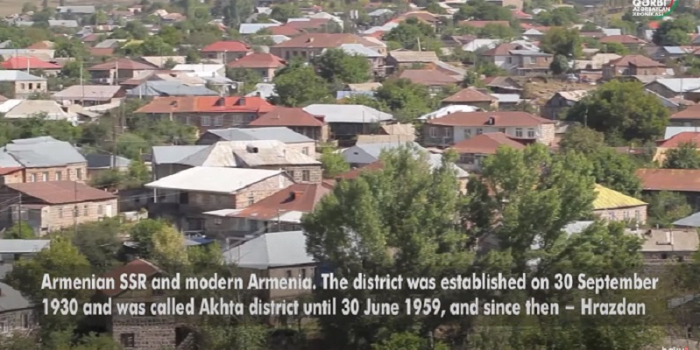The story, titled “The Homeland of Oghuz Turks, annexed to Kotayk province”, notes that the purposeful policy of the artificially created state called Armenia has always been aimed at changing the name of ancient settlements and losing their traces, at capturing the territories whose ethnic composition consisted of Oghuz Turks, For this purpose, the Hayer (Armenians) constantly committed genocide and forced people out of their native places.
It is noted that Akhta district, a historical settlement of Western Azerbaijan, was an administrative-territorial unit within the Armenian SSR and present-day Armenia. The district was established on 30 September 1930 and was called Akhta until 30 June 1959, and since then - Hrazdan. The center of the district, which had an area of 936 sq. km, was the town of Ashaghi Akhta. The distance from the district center to the city of Irevan was 50 km. The Zangi River and its tributary, the Beyukchay River with the modified name Marmarik, flow through the territory of Akhta district.
The story points out that all historical sources testify to the resettlement of Armenians from Iran and Türkiye to Akhta district.
“It was as a result of this that the number of Azerbaijanis gradually decreased. As a result of the Armenian-Azerbaijani conflict that took place in the early 20th century, in 1905-1906, Azerbaijanis were completely expelled from their homeland. Now only Armenians live in this territory. In 1897, as many as 119 Azerbaijani Turks lived here. At the beginning of the 20th century, in 1905-1906, Azerbaijanis were expelled from the village and it became a settlement of Armenians. In 1926, only 3 Azerbaijanis lived in the village, but they were expelled and Yukhari Akhta village was untied with the district center. Finally, by the decree of the Presidium of the Supreme of the Armenian SSR of 30 June 1959, the name of the district was changed to Hrazdan. The process of losing the name of the historical homeland of the Oghuz was not enough. Thus, 18 historical geographical names were changed by various decrees of the Presidium of the Supreme Soviet of the Armenian SSR,” the story says.
The author also states that the territory where Armenia is located today was the land of Azerbaijan 180 years ago.
“Armenians are an ethnic group that did not just come to the South Caucasus, but rather was brought there. The territory called “Republic of Armenia” inhabited by this ethnic group is the ancient and eternal land f Azerbaijan. This truth will exist as long as the Azerbaijan nation exists. We believe that Western Azerbaijanis, who are constantly subjected to financial and moral terror, will become masters of their native homeland and restore their rights lost in the territory of present-day Armenia. Because this is the requirement of time,” he adds.
The “Chronicle of Western Azerbaijan” project aims to preserve and popularize the name of our historical ancient lands and present to the world community the facts confirming the deportation of Azerbaijanis by the Armenians and the renaming of toponyms that existed in those areas.
As President of Azerbaijan Ilham Aliyev earlier stated, “the map dating back to the beginning of the 20th century once again shows that Western Azerbaijan is the historical land of Azerbaijan. The names of cities and villages are of Azerbaijani origin, and we know perfectly well that the Azerbaijani people have lived in the territory of present-day Armenia throughout history. The main task now was to let the whole world know about that.”
AzVision.az
More about: Azerbaijan WesternAzerbaijan Iran Armenia













































